Lubricating Oil & associated works
An alternative to an oil distribution depot would be a lubricating oil plant, where various oils are mixed with other ingredients, then placed in wooden barrels (very common up to the early 1920s), steel drums (became more common in the later 1920s) and bulk rail or road tankers. One advantage of such a works is that you can run in tankers for a number of suppliers, each bringing the products of that particular refinery, as well as vans bringing in the other ingredients for the mix.
Although usually best known for their lubricants the 'oil blending' firms produced a range of specialist products, for example special oils for electrical transformers and switches. This particular application was a big enough business for Shell to have dedicated fleets of tankers branded for electrical oils and even the more specialised products sometimes justified the expense of a tanker or two.
Lubricating and other specialist oils fall outside the Class A and B system (they have a very high flashpoint and do not represent a fire hazard), so the rail tanks could be any colour. In general they all seem to have been rather dull, often red oxide or black. Shell had some in chocolate brown with white markings in the later 1940s but by the mid 1950s their lubricating oil and electrical oil tanks were yellow with red and black markings as shown below left. The tank wagon shown below right was used to transport a thick oil used in the insulation of heavy duty electrical cable. It is also an unusual example of a non milk six wheeled tank, in the 1950s when this tank was in service they used resin thickened oils for cable compound, which I assume was very heavy. The livery was black with white markings.
Fig ___ Electrical Oils and Cable Compound tanks

A further type of oil, sometimes associated with these companies, is hydraulic fluid, used in hydraulic rams (which gained in popularity during and after World War Two as suitable seals were developed). I have not seen any references to railway tanks marked for this product.
Lubricating oils are the largest segment of the oil blending market, however oils for a large ships engine is very different to that used on a lawn mower. Lube oils do several jobs, as well as providing a slippery coating on bearing surfaces they may also serve to removed particles (some oils will dissolve some types of particle) and to transport heat away from the bearing surface.
Mineral oils contain waxes that can freeze at very low temperatures. During World War Two the Germans had problems with this in the Russian winters, but they found that their synthetic oils did not freeze (as they contain no waxes). Even in Britain during comparatively cold winters it was found that freezing lubricating oil was a problem (you could actually buy small paraffin heater to put under the car during winter to keep the oil warm enough to allow the engine to start in the mornings). After the war there was a continuing interest in synthetic oils and they are today a very important branch of the industry. The wax problem is not confined to lube oils, diesel fuel is comparatively 'heavy' and contains quantities of wax which can cause problems even in a British winter. In 1961 the Morris Lubricants company developed a product called Scyllan as an additive for diesel help deal with this problem. See also Lineside Industries Petroleum and LPG for more on synthetic oils.
A lubricating oil has a number of properties which are relevant to its duty however 'motor oil' is sold mainly on the basis of its viscosity (how thick it is), if this is too low the oil will be squeezed out from between the bearing surfaces, too high and it doesn't get in there in the first place. Viscosity used to be measured in Centistokes, these days it is measured in some metric unit the details of which I cannot remember. To simplify the marketing of oils used in engines the viscosity is measured on a numbered scale laid down by the Society of Automotive Engineers which gives an indication of the temperature at which the oil is intended to operate, the letter W (for winter) is sometimes added to indicate the cold weather functioning of the oil. Up to the 1970s it was normal to change the oil in a motor car in autumn and spring, using the appropriate oil for the season. Multi-grade oils (which appeared in the UK in the late 1950s) have a mix to two viscosities, when the engine is cold he lighter oil does the work and as it heats up the heavier oil takes over, this means the same oil can be used year round and saves the bi-annual draining and replacement (I understand that first such oil, a 20W50, was produced for the Mini engine in which the engine and gear box were combined).
In the engine the oil becomes contaminated with materials from the engine and some components of the oil will break down over time. It was normal to replace the oil about once a year, however some modern oils, introduced in the early 21st Century, last a lot longer and an engine can run for a couple of years without requiring an oil change. A side effect of this and other development is that modern European car manufacturers tend to use their own specification for oils rather than the old numbered viscosity system.
The science of lubrication, or tribology, is an important branch of engineering science and not for the mathematically challenged. Unpromising seeming materials such air drying linseed oil are used in some industrial lubricants.
Lubricating Oil Manufacture
Early lubricants were animal and vegetable oils and fats, and some products still use these as part of the mix. Lubricating oils are not all petroleum based, many early lubricants had no mineral oil component in them, the brand name Castrol derives from Castor Oil (on which the firm's first oils were based). Once the petroleum oil industry got going however the suitable fractions recovered at the refinery were soon employed and most modern lubricants are based on mineral oils with typically about 10 percent of the content being the various additives.
Most modern lube oils are based on crude oil which is split at the oil refinery using a 'fractionating column' (see also Lineside Industries - Petroleum and LPG). The oil suitable for lubricants taken from the fractionating column is then passed through ultra fine filters and further processed in the 'solvent extraction' plant where unwanted 'aromatic's' are removed by heating the oil and dissolving them in a solvent that does not mix with the desired oil. The resulting 'base oil' is then mixed with the additives that will give it the desired properties for its intended application. Not all crude oil produces equally suitable feedstocks for production of base oils, for example lighter North Sea crude is less suitable than material from the Middle East.
There are two main types of base oils: paraffinic and the less common naphthenic. There are only a small number of base oil grades, lubricant manufacturers or blenders blend these with their own recipe of additives to produce oils with the required properties.
In certain specialised lubricants bases other than petroleum-derived oils are used. For example, fire-resistant fluids are based on synthetic esters such as phosphate esters and mixtures of water and complex glycols, many metal working fluids contain water to give maximum cooling effect and synthetic materials like glycols to enhance their lubricating powers, and synthetic chemical compounds, called esters, are used as aviation engine lubricants.
In the post war period base oils were produced in the United Kingdom by BP, Shell, Esso, Burmah, Mobil, Philmac and Buchanan. As well as marketing their own branded products and supplying base oils to the blending industry the refinery owning companies and oil importers supplied finished lubricating oils to third parties who wished to retail them under their own labels.
There are a wide range of additives used including Lanolin (wool grease, a natural water repellant), vegetable and mineral oils, and synthetic oils (based on manufactured polyalphaolefins and other materials - see also Lineside Industries - Petroleum and LPG).
The last widely used motor oil with a high vegetable oil content was (I believe) Castrol 'R'. This stuff produced a distinctive smell, at race meetings if someone was using that oil everyone developed a distinct hankering for a bag of chips.
Fig ___ Castrol 'R' Logo

Grease is also produced by the oil blending firms, it is after all just a lubricant in solid form. Greases can be based on a range of materials including animal fats, petroleum based materials (waxes such as Vaseline, found on oil drilling rigs, the purified form was patented in 1872) and slippery solids such as graphite, Molybdenum Disulphide and PTFE (Polytetrafluoroethylene but referred to by one Chief Engineer I sailed with as 'pipe tape for engineers'). Solids can be mixed with each other or with liquid base oils to provide specific lubricating properties.
Lubricating Oil Blending Plant
Such an establishment would require a number of relatively small tanks, the oil tanks in the Ratio range of kits would serve for this but you could add a couple of larger tanks from aerosol can lids and plastic film canisters as well to justify more frequent supplies by rail tanks. Some ingredients might be delivered in railway tank wagons but a lot was shipped in barrels and drums, with some shipped in smaller 5 gallon drums and even smaller tins. Hence you get to run a range of stock into such a works including tank wagons, vans and opens and coal wagons (if they have a coal fired boiler on site).
Fig ___ Lubricating Oil Works

One characteristic feature of lube oil and other blended oil works was a large number of barrels and drums, up to the early 1920s there were a lot of the wooden barrels, in the 1930s there were perhaps 10 percent wooden barrels, by the 1950s there was just the odd one. The steel drums were often painted green or red but a lot were black, the top of the drums were often a different colour (white for example) and some firms had a coloured band round the drum to identify the contents.
Lubricating oils are also shipped out in tanker lorries (and rail tanks), larger engineering works, motor car factories and the like would also require a substantial delivery either by rail or road. Lube oil rail tanks going to a harbour might supply a ship (if it was small enough for gravity supply) but would be much more likely to load a 'bunker barge' which would attend the ship at anchor (or pull in on the off-side of the ship whilst she was alongside). A really big ship such as the Queen Mary passenger liner might require 20 or 30,000 gallons delivered in several 8-wheeled tanker loads (Cunard used Vacuum Oil Co (Mobil) oils in the 1930s), in the case of this ship they used Pickfords 8-wheeled tankers to handle the delivery but lube oil firms generally operated their own road tanker fleets.
Fig ___ Lubricating Oil tanker (1950s)
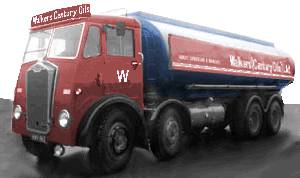
Reclamation of waste oils
A small number of companies in the United Kingdom have been involved in the reclamation or recycling of waste finished lubricants. The reclaimed oil has its uses but it is regarded with some suspicion and the cost of reclaimed oil is not that much lower than fresh. The oil can be reclaimed for re-use as a lubricant in two ways, known as 're-refining' and 'laundering'.
Re-refining recovers the base oil from the mix to be used in blending new products. This usually requires distillation to remove the original additives. Sternol were an early player in the field, having been asked by the government to look at it in the later 1930s. By the 1970s the main player in re-refining the oils was Century Oils of Stoke on Trent.
Laundering, or reconditioning, seeks to clean the contaminants from the oil so it can be re-used in its original, or in a lower grade, application. This may involve replacing some of the base oils or additives. In the 1970s Midland Oil Refineries were using this method, their capacity being leased by BP.
Common brands and companies operating branded rail tank wagons
Independent garages and independent distribution chains would use whoever they thought might sell, often offering more than one brand of lubricants, the petrol company owned stations that became increasingly common from the 1860s, would only (generally) sell their own in-house brands if there was one.
Lubricants were originally developed in the United Kingdom by small companies catering for local and specialised needs. Their products were originally based on animal and vegetable oils. With the advent of petroleum, and mineral base oils as a basis for lubricants, the oil companies became involved in the business. The oil companies catered to the large volume trade, notably 'motor oils' for use in cars and commercial vehicles, these officially include 'lubricating oils sold for the lubrication of engine and transmission units and auxiliary equipment fitted to licensed road vehicles, including sales to retail and commercial customers'.
The independents handled the more specialised side of the business but purchased their base oils from the oil companies (more detailed company histories of the major oil companies may be found in the section Lineside Industries - Petrol & LPG.).
In the 1920s and 30s there were comparatively few lubricating oil companies catering to the motorist on a large scale. The principal suppliers at this time were Wakefields (selling Castrol), Shell (who began selling lube oils in 1921), Vacuum Oil Co (better known today as Mobil Oil) and Anglo American Oil (Esso today) who entered the market in 1929. There were however a large number of small companies, some of which distributed on a national scale while others supplied only local markets. In 1930 there were over a hundred such small firms in Manchester alone, mainly catering to the needs of local industries. The small blenders were seldom direct importers but relied for their supplies of base oils on wholesalers. Four standard grades of oil were available generally (light, medium, heavy and extra heavy), retail prices being fixed by agreement with the Motor Trade Association.
In the post war era the oil companies began taking more interest in specialist oils, and there was a trend towards firms merging. From over 300 lube oil blending firms in 1945 there were less than 100 in the 1970s and the figure was below 50 in the early 21st Century (according to the British Lubricants Federation, formerly the National Lubricating Oil and Grease Federation)
The main suppliers of lubricants in the retail market in the twenty years following World War Two were Wakefield (now Castrol Ltd.), S.M. & B.P., Esso, Mobil and Regent. Petrofina entered the market in 1953 and there were a dwindling number of smaller specialist companies.
As well as railway tanks owned by the oil companies some of the larger independent firms who blend their own oils have operated railway tank wagons in their livery, the only examples I have found references to are shown below. Although most of the independents did not operate tank wagons I have tried to provide the logo to make 'stick-on' labels for the post war BR vans delivering drums and cans to the works.
Of the oil companies Mobil was probably the most important (trading as the Vacuum Oil Co but selling their Mobiloil brand, a British best seller in the 1930s). The picture on the left is a typical pre-war tank, that on the right is a 1950s livery, the logo sometimes has the word 'Mobilgas' in place of 'Vacuum' under the horse but that was for fuel oil (class B tanks)or petrol (class A tanks).
Fig ___ Mobil Lube Oil Tanks tank

The signs below show the typical pre and post war advertising for Mobil oils. Both were produced as enamelled plates for use in garages.
Fig ___ Mobil Lube Oil adverts

Esso sold their oils as Pratts Oils, and as Essolube from the mid 1930s.
Fig ___ Pratts and Esso Lube Oil adverts

Shell also sold their own branded lubricating oils at their service stations and to independent garage operators. They were sliglty unuisual in using a non standard colour for at least fome of their lubricating oil rail tanks in the post war era, yellow bodied with red lettering (most firms used standard Class B livery)
Fig ___ Shell Lube Oil adverts and rail tank


Texaco supplied stations, such as the Regent chain offered Havoline. This was created by Havemeyer Oil Company in New York in about 1904 Havoline was a 'wax free' motor oil that did not form a thick sludge in winter. The product and the brand was purchased in 1909 by Indian Refining Company who were in turn bought out by another American firm that eventually became Texaco. I am not sure when this brand appeared in the UK although it was reportedly selling well 'abroad' in the early 1930s. In 1947 Texaco and Chevron merged their UK operation under the brand name Regent and this may be when Havoline appeared in Britain). In 1962 Texaco changed the logo, replacing the old Indian logo (a red white and blue 'ball', introduced in 1922). Havoline drums were painted dark blue with a white band and head.
Fig ___ Havoline Logo (pre and post 1962)

BP They had access to the Price's range of oils from 1921 and later purchased Castrol (in 2000). In the 1950s BP changed the branding on the Price's oils to their own brand and in the 1960s. BP had already bought Duckhams (in 1969) but initially at least retained the brand. They Offered their Energol Visco Static range from at least the mid 1950s (the Energol name was already in use for BP lube oil products in France). Castrol, Duckhams & Price's are considered below.
C. C. Wakefield and Co. Ltd. The original company behind the Castrol brand lubricating oils. The firm was established in 1899 by a chap from the Vacuum Oil Co (the British arm of Mobil) and the name Castrol was chosen for their oil as it was a contraction of castor oil, from which their first lubricant was made. For some years pure castor oil was employed in high-powered petrol engines, it performed better at high pressures than mineral oils. There were however problems with it, for one thing it left sticky acidic deposits in the engine. Wakefield's solved the problem in the early 1920s by blending castor oil 'of great purity' with mineral oil (and a few secret additives). This was not easy as normally castor oil will not mix with a mineral oil. By the mid 1920s Wakefield's 'Castrol' was the oil of choice for all high performance engines and they went on to expand their range, producing oils for a wide range of applications. In 1960 the company changes its name to Castrol Ltd and in the early 1960s the took over another large independent firm 'Fletcher Miller'. Castrol became part of the Burmah group in 1966 and was then sold to BP in 2000. The illustration shows pre-war (left) post-war (centre) and 2008 BP versions of the logo.
Fig ___ Castrol logos

Castrol operated tank wagons from the early 1920s to the 1960s, the only livery I have seen is shown in Mr Tourret's book on Rail Tank Wagons(see bibliography). I gather they operated their pre-war tanks in all-over dark red, in the 1930s the markings were I believe simply the company name and contact details toward the left hand end of the tank.
Fig ___ Castrol tank

Fletcher Miller This firm, based at Hyde near Manchester, were operating from at least the 1930s. Two of their products were 'Flick Easing Medium' (a type of penetrating oil) and Swiftex cutting oil (used on lathes and drills). They were taken over by Castrol in the 1960s.
Duckham's Oil Based originally in Millwall, London and later moving to Kent, this company was established in 1899 as Alexander Duckham and Company and in 1904 they were incorporated as a limited company. By 1914 they were well known oil and chemical manufacturers specialising in oils and insulating materials, with their own patent oil separator. They also patented a system of electrical main laying. By 1937 they were dealing only in petroleum based products and had a range called Aero New Process Oils. Duckham's was the second largest of the independent UK blenders after Castrol, its Morrisol grades were recommended for use with Morris and Wolseley cars. In about 1950 the apostrophe was dropped so the name became Duckhams. The company was bought out by BP in 1969 and the name is still (I think) in use although BP subsequently took over Castrol and I understand they are pushing that brand as their standard.
Fig ___ Duckham's Oil logo
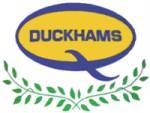
Morris Lubricants of Shrewsbury in Shropshire was established in 1869 and since BP took over Duckhams and Castrol it is now Britain's largest privately owned lubricants company serving the home market and exporting to over 50 countries worldwide. The works is rail connected and, into the 1990s at least, received regular rail shipments of base oil (and possibly additives), however as far as I am aware this firm has never had rail tanks in its own livery (although it has long maintained an in-house fleet of delivery lorries). In the 1930s their Golden Penna range of oils was highly successful (based on imported Pennsylvanian oils of high purity), during World War Two such imports were compromised by U-boats and they developed a new line called Golden Film, which remains as part of their range today (although it has been continuously developed). In 1961 they developed a product called Scyllan which was added to diesel fuel to prevent the waxes in the fuel freezing in cold weather, this became a major success for the company. They also introduced a range of anti-freeze and hand cleaning agents in the 1960s. Well known for supplying oils to steam enthusiasts (they produced an oil specifically for Sentinel steam lorries in the 1920s) they also offer a range called Golden Film Classic Oils specifically for the older cars and motorbikes for which the modern oils are unsuitable.
Fig ___ Morris Logo

Filtrate Oil was produced by Edward Joy and Son (sometimes referred to as Edward Joy Ltd, this may have been before the son was born) at or near to Wetherby in Yorkshire. The company was formed in 1807 and Filtrate Oil dates back to 1812, when it was used in miners' lamps. It was also used by George Stephenson in early steam locomotives in 1814, and was later taken in drums on Shackleton's ill-fated expedition to the South Pole. In the 1940s one firm selling clip-on motors for bicycles recommended the use of 'Colloidal Filtrate Oil' which I believe was a product of this company.
Fig ___ Filtrate oils advert
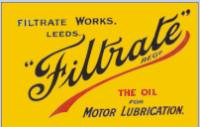
Valvoline Oil Co, the oldest trademark in the industry, dating back to the 1860s. Based in Birkenhead near Liverpool, this firm also produces a range of products including brake and clutch fluids and 'radiator stop leak'. They have operated branded rail tanks in Europe, but not as far as I can tell in the UK.
Fig ___ Valvoline Logos
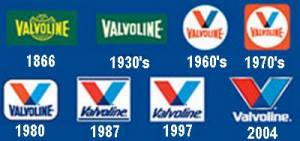
Price's was established in 1830 to make candles (using coconut oils, a revolutionary idea at the time). The project was a success and Price's remain a market leader to this day. By the 1850s they needed to find a use for the 'waste' by-products, mainly glycerine and a liquid fat called oleine. They successfully marketed the oleine oil to English woolen and cotton manufacturers as a 'cloth oil' where it quickly replaced olive oil for mechanical looms. The discovery of 'rock oil' or 'petroleum' in Burma in 1854 affected many industries which used vegetable raw materials and the new oil transformed the equally new paraffin industry (based on British shale oil). Price's oil from Burma to develop paraffin wax candles and for a time they were able to export the kerosene to the USA but then US oil deposits were discovered at Drake's well in Pennsylvania in 1859. Price's were left with large quantities of Burmese Oil or 'Rangoon Tar' that had fallen in value by 75 percent. Price's chemists were able blend the heavy waste oil left alter extracting the paraffin with animal and vegetable oleines to make a range of lubricants. For the first thirty years of the twentieth century Price's dominated motor oil market; their 'Huile de Luxe' and 'Motorine' were major products. As early as 1902 an attempt to drive to the South Pole was made using a car lubricated by Price's Oils as were, more successfully, the Norton motorbikes that won at Le Mans in the 1920's. Rolls Royce supplied new cars filled with Motorine oil. Price's was taken over by Lever Bros the soap makers in 1919, in 1921 they in turn set up a joint candle making company called Candles Ltd in 1921 with Shell, Burmah Oil and its offspring BP. Lever Bros sold their share to the oil companies in 1936, leaving the oil companies in possession of Price's brands and products. In 1951 the first multigrade oil, Price's "Energol",was developed at Battersea and demand for this highly successful product led BP to remove all the lubricating oil business to their oil refinery at Grangemouth in 1954 and re brand it as their own products; this ended Price's hundred years of involvement with lubricating oils. The candles business remained owned by the three oil companies until 1982, when Shell bought out its partners, before selling the company to management in 1998.
Fig ___ Prices oils adverts

The Miller Oil Company of Brighouse, West Yorkshire (est in 1887 and still going as Millers Oils) who sold the Millers Pistoneeze brand ('the Ace of Motor Oils') in the 1950s and earlier. By the early 21st century they were concentrating on speciality industrial lubricants and oils for the classic car market.
Thelson Oils were trading in the 1930s, they were at the time a significant company but I have not yet traced their history. They had depots in London and the Northeast of England.
Fig ___ Thelson logo and oil can
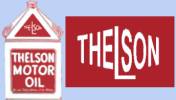
Walker Century Oils, based in Stoke on Trent was founded in 1874 to refine shale oil from a local colliery. The company distilled the oil at a refinery they built at Cobridge near Stoke on Trent. From the shale oil they produced axle grease, engine oil, paraffin, lamp oil and candles. They owned a small number of tank wagons, early examples seem to have been cylindrical although they did buy a second hand rectangular tank in 1945. They were used to ferry the products of the company about and collect feed stocks. In the post war era their main duties were taking flotation oils to collieries where it was used to separate the coal from coal dust (and recover the latter for use as pulverised fuel).
Fig ___ Early and post was Walkers tank wagons

They established a reputation as a manufacturer and supplier of lubricants; primarily to the industrial sector of the market. They did produce a range of motor oils however their products were generally only seen in 'trade' motor factors. In 1971 they purchased Snowdrift (another of the larger independents) and in turn Century were purchased by the German firm Fuchs in 1996 and merged with Silkolene to become Fuchs Lubricants (UK) Plc.
Fig ___ Royal Snowdrift Oil Logo
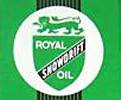
Silkolene was produced by Dalton and Company based in Belper (Derbyshire), the company name changed to Silkolene in the 1980s and they were purchased by the German firm Fuchs, who relocated production (which by then included a petroleum jelly plant) to Stoke on Trent in 2000. I am not sure when the Dalton and Company firm was established but in 1938 they were employed by the Air Ministry to look into ways of reprocessing used engine oils and subsequently made special lubricants for aircraft engines. After the war Silkolene went on to become a world leader in synthetic lubricants. The early logo used a flowing script, rather different from the more modern logo (shown top in the illustration below).
Fig ___ Silkolene Logos

Silkolene were purchased by the German firm Fuchs in 1996 and merged with Walkers Century Oils to become Fuchs Lubricants (UK) Plc.
Swarfega In 1941 a chap called chemist Audley Bowdler Williamson who served his apprenticeship as a chemist at Silkolene set up a small firm called Deb Ltd. based in Belper, selling a light washing solution for silk stockings. The Second World War brought in American nylons and Mr Williamson developed their product into a green jelly hand cleaner he called Swarfega, put on the market in 1947 with the slogan 'Cleans hands in a flash'. Swarfega would clean oil and grease from the hands without leaving the skin red and raw, Swarfega rapidly established itself as the brand leader in industrial hand cleaners and continues as such today. Swarfega works because of the power of its hydrophobic ingredients, the medium-chain alkanes and cycloalkanes that work in tandem with an emulsifier.
Sternol Ltd originally the Stern Sonneborn Oil Company Ltd (set up in London in 1886), who became Stern Ltd. and were trading as Sternol Ltd by 1916. They sold lubricants (initially based on castor oil I believe but by the 1930s they were firmly based on petroleum oil) under the Sternol brand. They were associated with aviation oils from before the First World War and produced a range of 'Sternoloil' lubricating oils and a product called 'Greasoline' for gear boxes. By the 1930s they had large factories at London (in present day Tower Hamlets) and Bradford, both sites equipped with large storage tanks. In the 1930s they seemed to sell a lot of 'aviation grade' lube oils but also sold 'Cable Compound' (which was loaded at 256 deg F into insulated road tankers for delivery), in the 1940s they sold a reclaimed oil (sometimes described as 'Green Sternol') for heavy industrial plant and one of their products was a hand cleaning agent called Sternoclense. I think they were part of the Lever Bros group, and they were definitely taken over by Elf in 1974, but Sternol branded aviation oils were still advertised in 2000.
Fig ___ Sternol logo and oil can

Speedwell Motor Oil Speedwell oils were marketed by the British Oil and Turpentine Corporation under the slogan "running made easy". This company existed in the 1920s and 1930s but had gone by about 1960 (as another firm was able to take up the name, they tune high performance cars). They were based in London, in what is now 'Docklands' and had their own wharf called Speedwell Wharf at one time, although this was badly damaged by fire in 1935. I think this may have been the successor to the British Turpentine Corporation, set up in 1904 to make turpentine substitutes using a 'new and secret process'. I have not been able to trace any further information on this brand.
Fig ___ Speedwell Logo
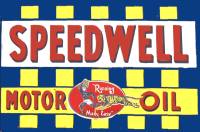
Mineral Oils Corporation (Minoco) was established at Silvertown in London in 1896 to distil and refine lubricants from Russian crude oil imported by a parent company, the Northern Petroleum Tank Steamship Co. of Newcastle upon Tyne (who were still operating in the 1952, they had a ship built in that year, and may still have existed in 1960). They operated some rectangular tank wagons with the name in full on the sides. In 1901–2 Minoco was reconstituted as Silvertown Lubricants Ltd., and grew into a profitable business supplying railways and other large users throughout the British Empire and in South America. In 1929 Silvertown Lubricants was acquired by the Gulf Oil Corporation, and in 1950 its name was changed to Gulf Oil (Great Britain) Ltd. The Silvertown works now concentrate on oil blending, and are no longer concerned with distilling or refining.
Fig ___ Silvertown Oils Logo
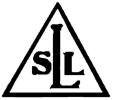
W. B. Dick and Co Established in 1853 but entered the lubricating oils market in the 1890s. W B Dick & Co built a thriving business supplying lubricants to the early iron ships such as the 'Great Eastern'. After the first World War the diesel engine emerged as a serious rival to steam. The company then began to specialise in diesel lubricants for engine types such as the early 'Doxford'. During this period W B Dick began to manufacture lubricants for Castrol's founder C C Wakefield. They were listed as 'Oil refiners, boilers, importers and rectifiers, distillers of turpentine' at the time of the First World War. Their early lubricating oils were all based on animal or vegetable oils, by the World War One however they were very much based on mineral oils, notably their Ilo range of oils. They had large establishments in Glasgow, Liverpool and London described as 'occupied with the refining and blending of oils', they also had an office in New York. When the 'national grid' was being set up in the later 1920s Dick's supplied over half of the transformer oil used for the project (Dick's Ilo Non-sludging Transformer Oil). Dick's maintained that Mr. James 'Paraffin' Young, who established the Scottish shale oil industry solved the problems associated with that work whilst working as Dick's first chemist. The company merged with Castrol in 1946, becoming Wakefield-Dick Industrial Oils and Wakefield-Dick Lubricating Oils in 1955, providing Castrol with a marine oils division. By the 1960s their Ilo Oil brand was marketed branded as a product of Castrol Marine.
Fig ___ W B Dick & Co tank
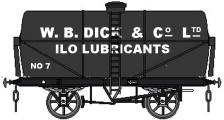
W. Blackwell Oil Co Based in Birmingham this company produced a range of blended oils, they were active in the later 1930s, selling their 'Nulsec' brand of oils, but I can find no trace of them after World War Two.
Fig ___ Nulsec Logo
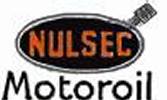
Veedol Originally an American company based in New York they expanded into Europe and to a smaller extent into the UK market in (I believe) the 1920s. They were bought out by Texaco in 1937, but the brand was established and continued in use throughout Europe. In 1970 the company was bought by Burmah Oil, who kept the brand in parallel with Castrol (which they now also owned). The name seems to have been retired in Britain by the 1960s, although in the early 21st century it was the best selling oil in German workshops. Now owned by BP, who are encouraging a change to the Castrol and Aral brands instead. I believe the logo shown below left would serve for the UK pre-war and the can for the later 1930s and post war eras. There is little information available on this firm's trading in the UK and I have not traced any suggestion they owned railway tanks in this country.
Fig ___ Veedol Logo and oil tin

FUCHS LUBRICANTS (UK) PLC. This company is a is a subsidiary of FUCHS PETROLUB AG, the world's largest independent lubricant manufacturer. The UK operation was formed in 1996 when Silkolene and Walkers Century Oils were purchased and merged to form the new company.
^
Go to top of page


























